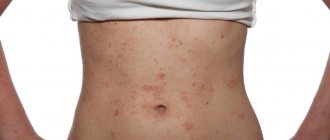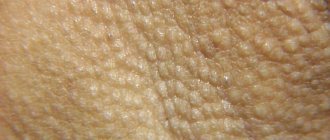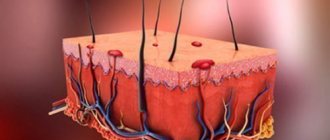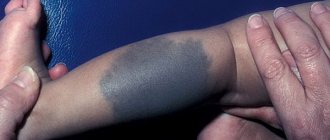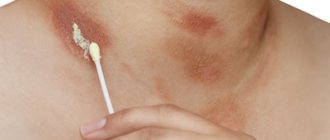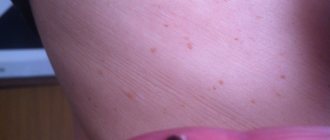White spots on the penis can appear for various reasons, including due to insufficient or improper self-care. Also, small spots can be a symptom of some serious disease. Treatment will depend on the diagnostic results. Most often, a man needs to reconsider how he takes care of his body, pay more attention to hygiene, the quality of the underwear and cosmetics used. If the cause of the appearance of dots on the penis is a disease, then it is treated with medications - tablets, powders, ointments, as well as folk remedies.
Features of scrotal pigmentation
The scrotum is a skin-muscular sac that contains the male sex glands. Located between the anus and the penis, covered with sparse hair.
The evolutionary significance of the organ lies in the placement of the testicles outside the main body. At the same time, a lower temperature is maintained in the scrotum - about 27 degrees, which promotes the production of enzymes necessary for normal sperm production.
The organ is formed at the 3rd month of intrauterine development of the child. The color of the skin of the scrotum can change throughout life. A peculiarity of this organ is that normally the pigmentation of the scrotum is somewhat darker than in other parts of the body. It may darken with age.
Reasons for changes in pigmentation in the absence of pathological processes:
- increased melanin production;
- friction of the outer membranes of the organ against underwear;
- injuries;
- damage to the skin by chemicals over a long period of time - residues from laundry detergents.
A change in color by several tones without signs of inflammation or peeling is not a cause for concern. If the skin on the scrotum suddenly turns red or a dark pigment spot appears and it expands, you should immediately consult a doctor.
Where does penile mycosis occur?
Genital mycoses usually develop in the female genital tract. In men, infection most often occurs through sexual contact. You can also become infected with the yeast Candida albicans from a towel, toilet, swimming pool or sauna. In the male body, mycosis of the penis rarely develops independently, although such situations also occur.
Factors contributing to this include:
- taking certain medications, especially antibiotics and steroids;
- neglect of hygiene of intimate places - too infrequent or careless washing;
- anatomical problems, especially phimosis, preventing free access to the glans penis;
- inaccurate drying of the penis after swimming, before getting dressed;
- use of wet towels;
- wearing thick, windproof clothing and underwear made of synthetic materials.
Remember that the ideal conditions for yeast development are a combination of heat and moisture. It is also easier for people with weakened immune systems (such as HIV-infected people) and diabetics to develop infections.
Symptoms and causes of age spots on the penis
The appearance of pigment spots on the penis or, conversely, loss of pigment is a sign of pathological processes occurring in the body.
Causes of unpleasant symptoms:
- Vitiligo is a loss of the pigment melanin, which provides color to the skin. The cause of the disease is unclear and there is no treatment. Vitiligo is considered an autoimmune process.
- Pigment spots on the penis of an inflammatory nature are a sharp change in the color of the skin. Develops suddenly. The reasons are varied - organ injuries, tissue irritation due to excessive sexual activity.
- Bruise – soft tissue injury. Accompanied by swelling. Shades can be very diverse - from red to dark green or purple. It depends on the force of the blow.
- Hyperemia of bacterial origin - pigmentation of the foreskin is accompanied by pain, discharge from the urethra, and the head of the organ is affected. The nature of the disease is possible.
- Itchy red formations on the head of the penis are the suspected cause of balanoposthitis of an allergic or bacterial nature.
- The appearance of areas of pigmentation, accompanied by itching and peeling - possible causes are eczema, psoriasis, genital herpes, yeast infection, allergic reaction.
- Pigmented spots on the head in men with a white coating indicate infection with fungi of the genus Candida.
Symptoms depend on the cause of the disease. Normally, the penis, scrotum and perianal fold should be slightly darker than the rest of the skin and not bother the man.
If there is discharge, pain, itching, or the skin begins to peel, you should undergo a comprehensive examination by a urologist or dermatovenerologist.
Mycosis of the penis
The content of the article
Mycosis of the penis, also called candidiasis or thrush, is an inflammatory disease of an infectious nature, most often caused by Candida albicans. This disease is often overlooked (due to the possible lack of symptoms, ignorance of the problem, or the shame that accompanies the disease), but you should know that if left untreated, it can lead to health problems in the long term, such as:
- yeast inflammation of the glans and foreskin;
- erectile disfunction;
- infertility;
- tumors.
Infertility
What are the causes of mycosis of the penis? How to detect it? How to recognize the disease? Which doctor should you contact for help? What drugs should be used in therapy and how to dose them?
Features of spots in various diseases
Each disease, accompanied by the appearance of spots on the skin, has its own characteristics. Pigment spots on the genitals are no exception. This allows you to diagnose the cause of the pathology.
We recommend reading
- What is and features of Dubreuil's melanosis
- Causes of pigmentation above the upper lip
- Types and classification of skin hyperpigmentation
Characteristic features of spots on the genitals in various diseases:
- Vitiligo is a white patch that does not hurt, does not peel, and does not cause itching. After prolonged contact with ultraviolet radiation, tissue burns develop.
- Bruises and hematomas of traumatic origin - it is difficult not to notice the onset of injury, since the penis is saturated with nerve endings. They are painful to the touch, but do not expand and resolve on their own over time.
- Spots due to sexually transmitted diseases are accompanied by itching and discharge from the urethra. With syphilis - in the primary period - a painless ulcer is formed. This is called chancre. It has smooth edges and a deep red color.
- Herpetic rashes, eczema, manifestations of psoriasis - are accompanied by itching, pain, the appearance of blisters with liquid contents, and peeling.
- Candidiasis – there is itching, hyperemia, a white coating appears on the head of the penis.
Harmless reasons
If a spot on the foreskin appears after sexual intercourse, then first of all you should exclude chafing, which is often found among lovers of aggressive sex. This problem also occurs in adolescents after prolonged masturbation. Small abrasions go away quickly and do not hurt. The situation is more complicated when a weeping wound appears at the site of the lesion, which takes a long time to heal and becomes covered with a crust. It should be remembered that even a small wound on the foreskin is a potential threat of infection and the development of an inflammatory process.
Allergies are the most common cause of red spots on the foreskin. May be caused by using the following things:
- condoms;
- personal hygiene products;
- lubricants;
- cream;
- underwear (especially synthetic ones).
The most dangerous and serious damage can occur after using depilatory creams or drugs to remove condylomas/papillomas. Such wounds are called chemical burns and leave behind serious scars on the skin of the penis.
Less commonly, a spot on the foreskin appears as a result of injuries received during aggressive sexual intercourse, masturbation, or the use of a pump to enlarge the penis. First, a bruise appears on the penis, which after 3-5 days becomes discolored and takes the form of a flesh-colored spot.
Let’s also not forget about skin pigmentation, which is more common in adult men. Colorless spots appear on the foreskin along the entire length of the penis, not accompanied by any symptoms.
Treatment methods
Treatment measures begin with diagnosis. If strange pigmentation appears on the genitals, you should contact a dermatologist, andrologist or urologist; if you have a bruise or other injuries to the genitals, you should contact a urologist-surgeon or, if a doctor of this specialty is not available, a surgeon or traumatologist.
Diagnostic measures include:
- physical examination;
- analysis for STDs and fungal infections;
- blood for syphilis;
- if necessary, check hormonal status;
- specific scrapings for suspected psoriasis.
If you suspect the development of oncological processes, the doctor will recommend an ultrasound scan of the testicles and scrotum.
Further management of the patient depends on the reasons that caused pigment spots on the genitals. Therapeutic tactics for various diseases of the reproductive system are as follows:
- STDs, syphilis – injectable antibiotics, antibacterial drugs. Long-term observation.
- Mycoses - antifungal drugs orally, in case of severe damage - injection. Antimycotic ointments locally.
- Vitiligo is a loss of pigment that currently has no cure.
- Genital herpes - acyclovir preparations, other antiviral agents, suppositories with interferon, local anti-inflammatory and antiherpetic agents.
- Psoriasis and eczema - the use of corticosteroids is indicated.
- Balanoposthitis - topical antibacterial drugs.
- Injuries - fractures, tissue ruptures - surgical treatment is possible. In case of bruises, rest the damaged organ.
Self-medication or the use of traditional methods is inappropriate. It is impossible to independently diagnose the disease and identify the cause of the appearance of age spots on the penis and scrotum.
How to use ointment for mycosis of the penis?
Ointment for mycosis of the penis is used for about 7 days. You need to rub the drug in several times a day, as recommended in the leaflet. Special hygiene should be observed, washing hands thoroughly before and after applying the ointment. If symptoms do not resolve within one week, systemic therapy may be required.
Especially in this case, it is important to read the dosage instructions carefully. Fluconazole is used for different types of mycoses in different doses and time intervals. To treat penile candidiasis, take only one tablet containing 150 mg of the active substance. Unlike vaginal yeast infections, maintenance doses are not used.
ONLINE REGISTRATION at the DIANA clinic
You can sign up by calling the toll-free phone number 8-800-707-15-60 or filling out the contact form. In this case, we will contact you ourselves.
If you find an error, please select a piece of text and press Ctrl+Enter
Classification of spots by color
The cause of pigmentation can be determined depending on the color:
- Red is a sign of inflammation, candidiasis or genital herpes, a consequence of a burn or allergy.
- Black – birthmark or tissue necrosis.
- Brown – venereal disease, fungus.
Situations when spots are accompanied by unpleasant symptoms require contacting a doctor. This is persistent and sometimes unbearable itching, burning, soreness, redness and inflammation of the skin around the lesion, swelling of adjacent tissues, the appearance of erosions, ulcers, purulent or vesicular rashes and other abnormal sensations.
What should I do?
If a man finds brown spots on the skin of his penis, the most reasonable decision would be to visit a doctor. However, in some cases you can do without this by coping with the problem on your own. As mentioned above, this applies to cases of hyperpigmentation, which can be ignored if they are not accompanied by oncological processes, as well as local allergic reactions, skin irritation, and minor mechanical injuries.
In the mentioned cases, it will be enough to follow a few simple rules, namely:
- Elimination of traumatic effects (friction, allergen, prolonged sweating, etc.). More thorough and enhanced hygiene of the intimate area.
- It is recommended to avoid using complex care products during hygiene procedures, especially if skin damage is caused by an allergic reaction. You can get by with baby soap or just water.
- It is advisable to treat the skin of the penis with antiseptic agents to prevent infection. It is recommended to take baths with infusions of medicinal herbs, such as chamomile and oak bark, 2-3 times a day.
- Create the most comfortable conditions for the intimate area. Do not wear tight underwear or clothes made of synthetic fabrics, and avoid excessive sweating if possible.
If the resulting spots do not have a pathological nature, but are a local reaction to a negative impact, then after a couple of days of such care they will at least lose their intensity, and then disappear altogether. If this does not happen, you should consult a doctor, since the cause was most likely incorrectly identified. This is especially true in cases in which:
- spots increase, change in volume, area, quality;
- other symptoms appear, for example, discharge, pain;
- there is discomfort when urinating;
- the general condition of the body worsens.
These signs indicate a developing disease, which should only be diagnosed and treated by a doctor. Many of these diseases, which cause brown spots on the penis in men, are also transmitted through sexual contact. Therefore, from the moment this sign is discovered, you should refrain from intimacy, in any case, until the cause is established, or better yet, until the spot disappears.
How to treat pigmentation on the genitals
If pigmented tumors appear on the penis, your doctor will determine how to get rid of them. Features of treatment depend on the primary pathology.
This:
- drug therapy;
- surgical therapy;
- cosmetic treatment;
- folk treatment.
In most cases, they manage with medications that are selected taking into account the cause of pigmentation. For fungus on a member of the epidermis, it is necessary to take tablet medications and local remedies applied externally.
Systemic therapy is carried out with the drug Terbinafine, and local therapy with Clotrimazole, Ketoconazole, etc. Before applying the antifungal agent, the area with pigmentation is treated with an antibacterial drug. This is Chlorhexidine or Miramistin.
Allergic manifestations in the genital area require exclusion of exposure to the provoking factor. Antihistamines are used in combination, and in severe cases, corticosteroids. Cosmetic procedures, such as laser therapy, are prescribed for the formation of post-traumatic scars.
It is imperative to visit a doctor in the following conditions:
- if the tumor increases in size, the volume, area, and quality change;
- if other symptoms occur, for example, the discharge of unnatural exudate from the urethra, the appearance of pain, etc.;
- if there is pain at the time of urination;
- if the general condition worsens, unreasonable weakness and malaise occurs.
Such symptoms do not necessarily indicate a disease of the genital organs, but require a comprehensive diagnosis.
